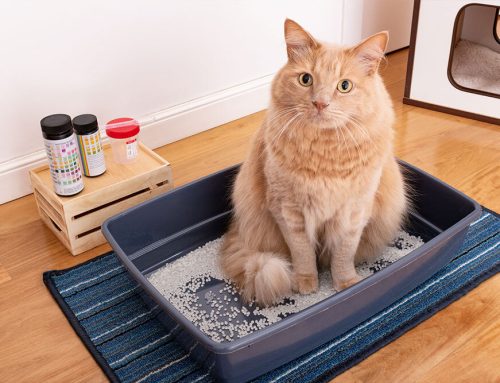The thyroid is a segmented endocrine gland that sits over the trachea in the neck and produces hormones that regulate many important body functions. Thyroid diseases and subsequent dysfunction are common in both dogs and cats, but each species exhibits different signs and symptoms. Dogs commonly develop hypothyroidism (i.e., low functioning thyroid), while cats develop hyperthyroidism (i.e., overactive thyroid). Because these diseases are so common in pets, Driftwood Animal Hospital wants you to ensure you can recognize early disease signs, so you and your veterinarian can address the diseases proactively.
What is the thyroid gland’s purpose in pets?
The thyroid gland secretes several hormones synthesized from dietary iodine that circulate in the blood and influence almost every major body system. Some pets may have ectopic (i.e., out of place) thyroid tissue that also contributes to hormone secretion and regulation. Thyroid hormones play a major role in metabolism down to a cellular level, which can affect the following:
- Body temperature
- Weight
- Skin and coat health
- Nutrient processing
- Heart function
- Reproduction, growth, and development
- Brain and nervous system function
What are thyroid disease signs in dogs?
The most common thyroid disease in dogs is hypothyroidism, where their immune system attacks the gland and causes low thyroid levels (i.e., autoimmune disease), or the reason for the low level is unknown (i.e., idiopathic). Autoimmune hypothyroidism typically affects younger pets, while the idiopathic form is most commonly diagnosed in middle-aged to older dogs. Regardless of the cause, hypothyroidism causes the following signs:
- Weight gain or difficulty losing weight
- Low energy level
- Normal to poor appetite
- Heat-seeking behavior
- Chronic skin infections
- Hair loss or thin hair coat
Rarely, dogs may develop an over-functioning thyroid because of a tumor on the gland, which causes signs similar to hyperthyroidism in cats.
What are thyroid disease signs in cats?
Hyperthyroidism (i.e., thyroid gland overactivity) occurs frequently in mature adult and senior cats, typically caused by a benign tumor or gland overgrowth that results in the gland producing excessive thyroid hormone. Increased hormone levels speed up metabolism and make the heart work harder, and generally more seriously affect the pet’s health than low thyroid levels. Hyperthyroidism in cats may cause the following signs:
- Significant weight loss
- Rapid heart rate, heart murmur, or heart disease
- High blood pressure
- Retinal detachments and blindness
- Increased energy and vocalization
- Increased appetite
How is thyroid disease diagnosed in pets?
Thyroid disease is diagnosed in dogs and cats by measuring blood hormone levels. An initial screening test measures total T4, which may or may not be abnormal. If the total T4 is normal, but your veterinarian still suspects thyroid disease, they will likely test the blood again to measure free T4 and T3, and to check for antibodies that could be damaging the gland. Imaging tests such as ultrasound can also be helpful in some suspected tumor cases.
How is thyroid disease treated in dogs?
Treatment for dogs with low thyroid is relatively simple—the missing hormones can be replaced with a daily synthetic pill. Your veterinarian will calculate a dose based on your pet’s weight, check their thyroid levels four to six weeks later, and make adjustments as needed, until the level reaches the ideal range, and your pet needs monitoring with blood tests only once or twice per year. Pregnant and nursing pets need more thyroid hormone, so breeding pets may need more adjustments. As long as hypothyroid dogs continue taking their medication, they can live perfectly normal lives.
Dogs with hyperthyroidism caused by a tumor need prompt treatment to remove the gland and tumor, with possible additional treatments to ensure the tumor doesn’t spread.
How is thyroid disease treated in cats?

Treatment of overactive thyroid in cats is more complex and more often results in complications, partly because older cats with thyroid disease often have other chronic health conditions, and balancing all their needs can be challenging. Sometimes thyroid disease can mask kidney failure, so kidney function may decline after successful thyroid disease treatment. All treated cats need blood work every few months to ensure the treatment is working correctly, and their levels are not dropping too low. Treatments for hyperthyroid cats include:
- Radioactive iodine — This gold-standard treatment uses radioactive iodine to kill the overactive thyroid cells. Pets must be hospitalized at a specialty center and isolated until they no longer have the radioactive element in their system. Following treatment, some cats need hormone replacement pills because their thyroid is low.
- Daily medication — Medication called methimazole can suppress thyroid hormones, but must be taken consistently each day. Some cats experience side effects, while others tolerate the medication well. If pills are not possible, this medication can be compounded into a cream that’s absorbed through the skin.
- Special diet — The thyroid gland needs iodine to make hormones, so a diet that contains no iodine can lower hormone levels in some cats. This treatment works only if the cat eats nothing else than their special prescription food—they cannot chew on grass outside, or eat treats or another pet’s food.
Thyroid disease is common in pets, but staying vigilant to changes in your pet’s health can help you detect the disease earlier and reduce complications. Baseline blood work taken during annual wellness exams can help our Driftwood Animal Hospital team track changes in your pet’s thyroid levels. If your pet is due for their wellness exam, or you’ve noticed any concerning changes, call us to schedule a visit and blood work.








Leave A Comment